
| Amount of gross power production/TWh | Share of gross power production/% | | Nuclear | 76 | 11.7 | | Lignite | 148 | 22.8 | | Hard coal | 93 | 14.1 | | Natural gas | 86 | 13.2 | | Mineral oil | 6 | 0.8 | | Others | 28 | 4.1 | | Renewables | 218 | 33.3 | | Overall | 655 | 100.0 |
|
|
Tab.1 Share of gross power production in Germany in 2017
|

| Renewable power production/TWh | Share of renewable power production/% | | Wind energy | 106 | 16.3 | | Photovoltaic | 40 | 6.1 | | Biomass | 46 | 6.9 | | Hydro | 20 | 3.1 | | Waste | 6 | 0.9 | | Overall | 218 | 33.3 |
|
|
Tab.2 Share of renewable energies related to gross power generation in Germany in 2017
|

|
|
Fig.1 Increase of renewable energies in Germany up to 218 TWh in 2017 (adapted from Ref. [2]).
|
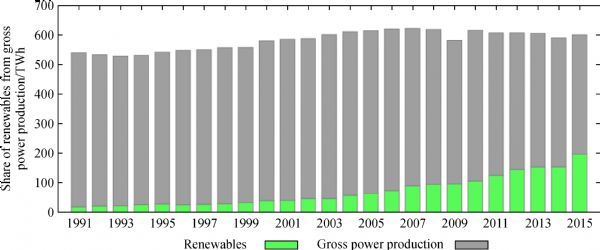
|
|
Fig.2 Gross power production in Germany including share of renewable generation (adapted from Ref. [3]).
|

| Amount of netpower production/TWh | Share of netpower production/% | | Nuclear | 72.1–72.0 | 13.2–13.3 | | Lignite | 134.0–131.2 | 24.2–24.3 | | Hard coal | 83.3–75.7 | 15.7–14.0 | | Natural gas | 46.6–40.0 | 8.4–7.4 | | Renewables | 210–217.3 | 38.5–40.2 | | Overall | 546–540 | 100 |
|
|
Tab.3 Share of German net power generation in 2017 resp. 2018
|

| Amount of renewable power production/TWh | Share of renewable power production/% | | Wind energy | 103.6–109.8 | 18.8–20.2 | | Photovoltaic | 38.4–45.8 | 7.0–8.5 | | Biomass | 47.7–44.7 | 8.7–8.3 | | Hydro | 20.4–17.0 | 4.0–3.2 | | Overall | 210–217.3 | 38.5–40.2 |
|
|
Tab.4 Share of renewable generation based on German net power generation in 2017 resp. 2018
|
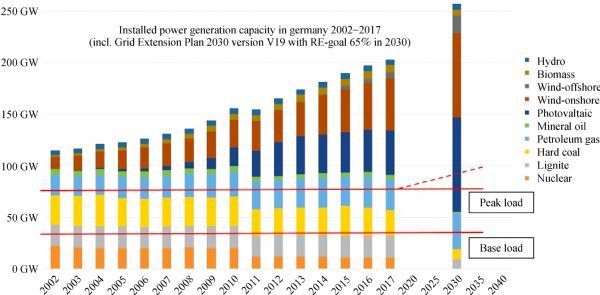
|
|
Fig.3 Installed electric power generation capacity and power demand in Germany from 2002 to 2017 and planning scenarios for 2030 .
|

| Secured power generation capacity of conventional power station [7] | | Secured power generation capacity of renewable power generation [8] | | Types | Percentage/% | Types | Percentage/% | | Nuclear power stations | 93 | | Running water power stations | 25 | | Lignite power stations | 92 | Biomass power stations | 65 | | Hard coal power station | 86 | Wind generation off-shore | 2 | | Natural gas (gas and steam units) | 86 | Wind generation on-shore | 1 | | Natural oil | 86 | Photovoltaic | 0 | | Fast starting gas turbines | 42 | | |
|
|
Tab.5 Factor of secured power generation capacity for different types of generation in Germany
|

|
|
Fig.4 Secured electric power generation capacity and power demand in Germany from 2002 to 2017.
|
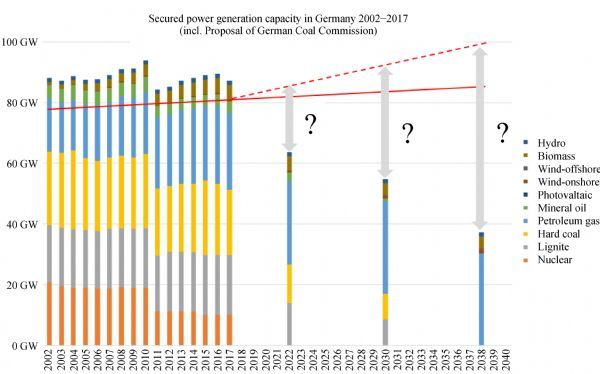
|
|
Fig.5 Secured power generation capacity in Germany up to 2017 including proposals from German “Coal Commission” up to 2038.
|
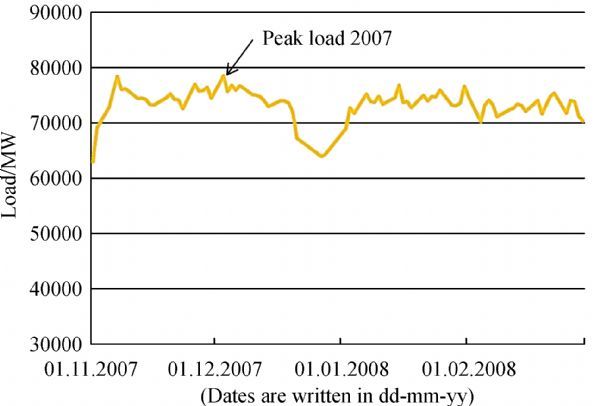
|
|
Fig.6 Peak load in 2007 with 78.5 GW and the daily demand maxima on each of the working days in winter 2007/2008 (adapted from Ref. [7]).
|

|
|
Fig.7 Contribution of different generation units to the German energy mix in week 06/2018 (adapted from Ref. [9]).
|

|
|
Fig.8 Contribution of different generation units to the German energy mix in week 50/2018 (adapted from Ref. [9]).
|

| CO2 emissions caused by combustion process
/(kg·MWh–1) | CO2 emissions caused by exploitation and transport to Germany/(kg·MWh–1) | Total CO2 emission from the global point of view/(kg·MWh–1) | | Lignite | 930 | 35 | 965 | | Hard coal (German Mix) | 735 | 235 | 970 | | Natural gas with pipeline transport from Norway | 335 | 365 | 700 | | Natural Gas with pipeline transport from Russia | 335 | 445 | 780 | | US-shale gas with LNG transport | 335 | 745 | 1080 | | Natural gas with LNG transport from Algeria | 335 | 475 | 810 | | Natural gas with LNG transport from Katar | 335 | 485 | 820 |
|
|
Tab.6 Global CO2 emissions of natural gas use in German power stations
|

|
|
Fig.9 Share of renewables within E.DIS grid exceeding 100% (red bars) while German average being around 33% (black bars) (revised from Ref. [22]).
|

|
|
Fig.10 Installed renewable generation capacity within E.DIS grid exceeding grid peak load (upper red line) by factor 4 and base load (lower red line) by factor 17 (revised from Ref. [22]).
|

|
|
Fig.11 Feedback from 110 kV distribution grid of MitNETZ Ltd. toward the 400 kV transmission system in Dec. 2017 (blue line below the gray area) (revised from Ref. [22]).
|

|
|
Fig.12 Feedback from 110 kV distribution grid of MitNETZ Ltd. toward the 400 kV transmission system in Apr. 2018 (blue line below the gray area) (revised from Ref. [22]).
|

|
|
Fig.13 Average of power flow (green curve in MW) and energy (blue curve in MWh) between 400 kV and 110 kV grid at substation GRAUSTEIN in 2017.
|
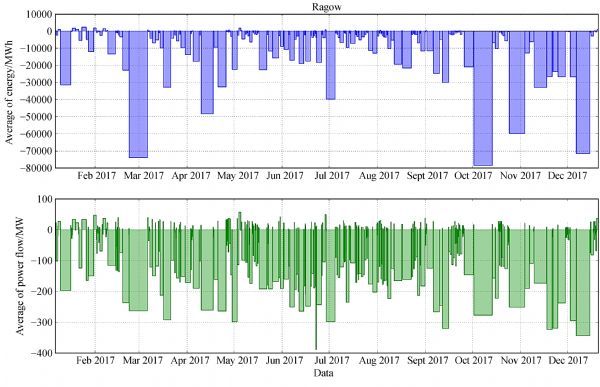
|
|
Fig.14 Average of power flow (green curve in MW) and energy (blue curve in MWh) between 400 kV and 110 kV grid at substation RAGOW in 2017.
|

|
|
Fig.15 Averaging of power flow between 400 kV and 110 kV grid at substation GRAUSTEIN in Jan. 2017 (real power flow in blue, rms–value of power flow in orange).
|

|
|
Fig.16 Overall estimation of network engagements within all German transmission and distribution grids.
|
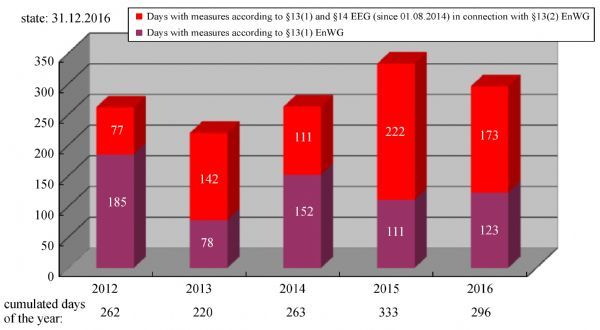
|
|
Fig.17 Network engagements per year according to EnWG §13 (part 1= pink) and (part 2= red) within 50 Hz-transmission Ltd.
|

|
|
Fig.18 Overproduction of electricity in Germany at the nights of Jan. 3rd, 4th, and 5th, 2018 (red line indicates the actual power demand) (adapted from Ref. [16]).
|
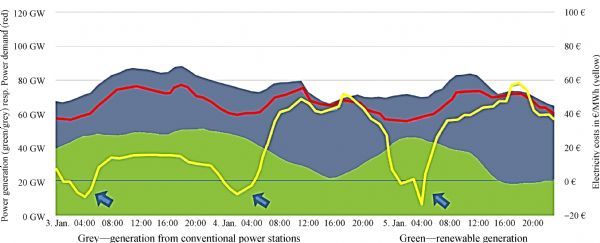
|
|
Fig.19 Similar picture to Fig. 18, now including the electricity prices (yellow curve) (adapted from Ref. [16]).
|

|
|
Fig.20 Infeed from wind energy in 2017 in Germany with its installed capacity of 56 GW (red line) (revised from Ref. [17]).
|
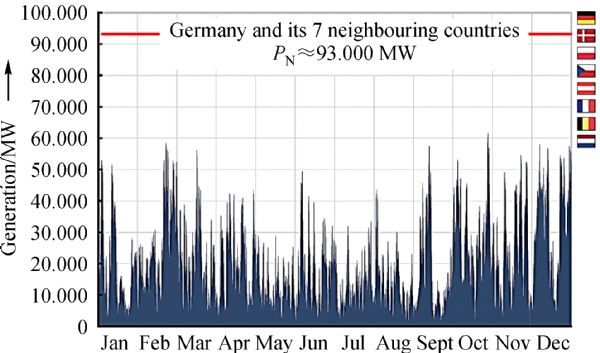
|
|
Fig.21 Infeed from wind energy in 2017 in Germany and all its neighboring countries with an installed capacity of 93 GW (red line) (revised from Ref. 17]).
|

| Border between Germany and | Power demand in the related country, when Germany is on 100% of its annual power demand / % | Transport capacity of cross border going high voltage lines/ GW | | Poland | 96 | 1.6 | | Czech Republic | 91 | 2.8 | | Austria | 92 | 6.0 | | Switzerland | 90 | 4.0 | | France | 84 | 4.7 | | Belgium | 93 | - | | Netherlands | 100 | 1.7 | | Denmark | 96 | 2.2 | | Sweden | 83 | 0.6 |
|
|
Tab.7 Percentage of national peak load in Germany’s neighboring countries at the day of peak load in Germany
|
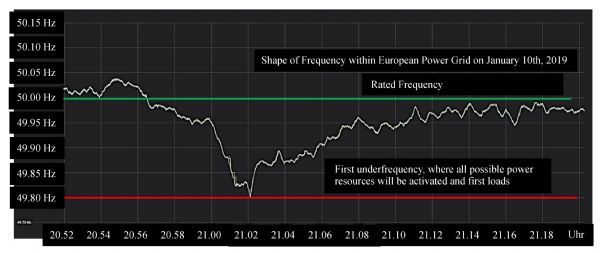
|
|
Fig.22 Frequency curve at 9 p.m. on Jan. 10th, 2019 (revised from Ref. [19]).
|
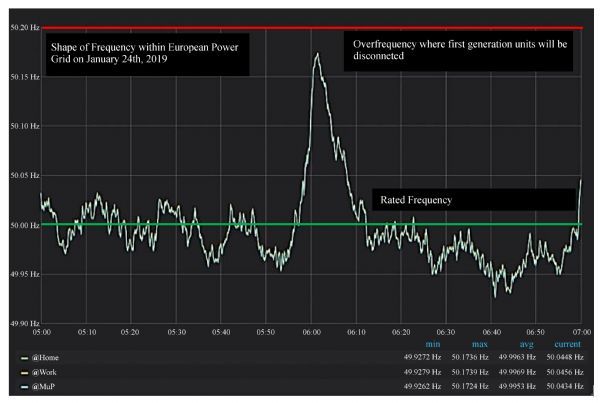
|
|
Fig.23 Frequency curve at 6 a.m. on Jan. 24th, 2019 (revised from Ref. [19]).
|

|
|
Fig.24 Composition of average electricity price for a German households using 3500 kWh per year (adapted from Ref. [20]).
|
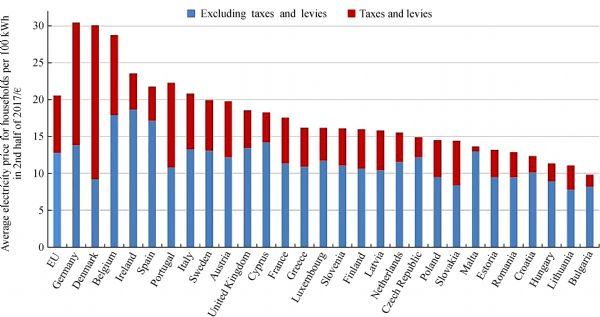
|
|
Fig.25 Electricity prices for households in all European countries (adapted from Ref. [20]).
|
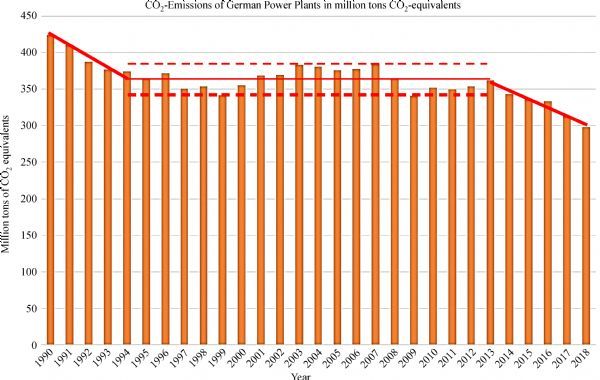
|
|
Fig.26 Development of CO2 emissions from power industry in Germany (based on data from [21]).
|